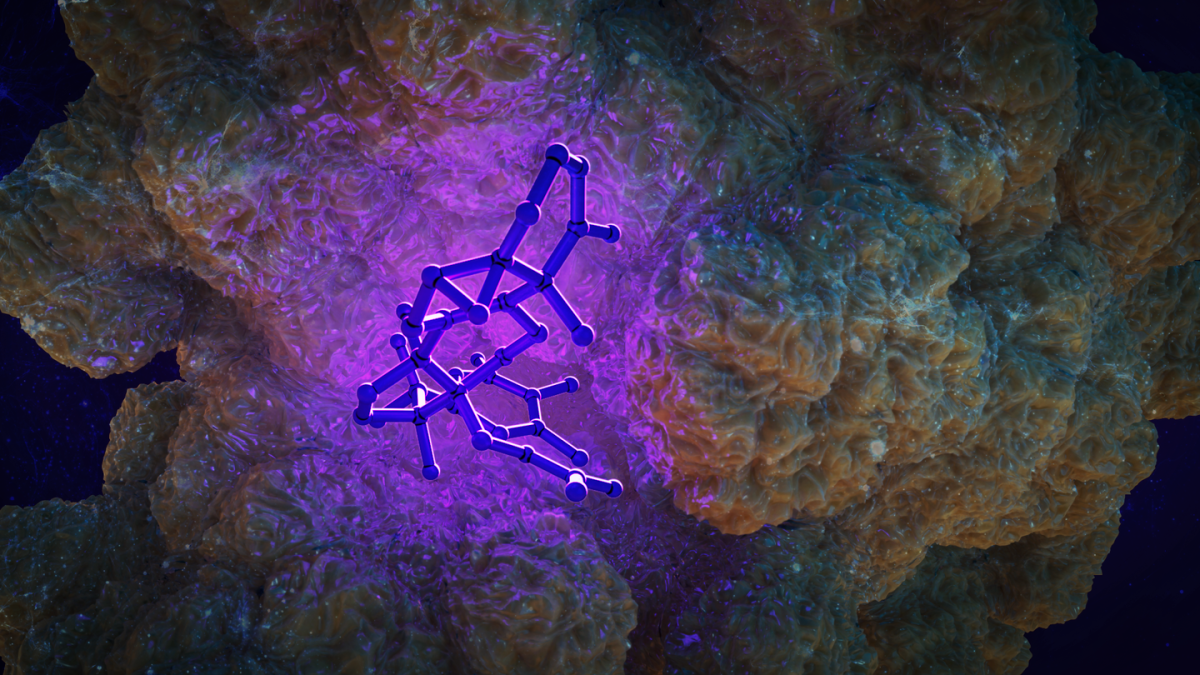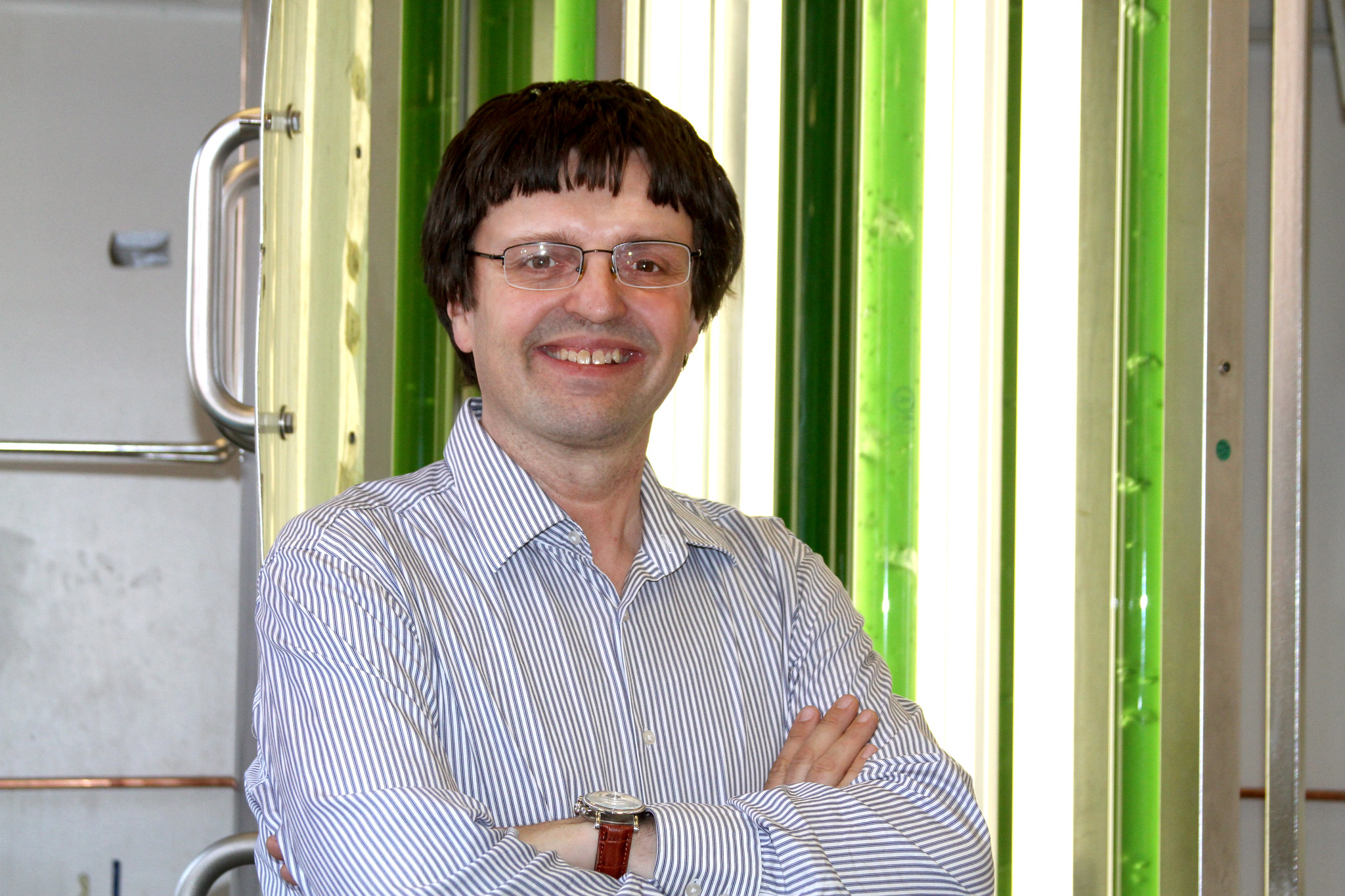Compounds found in plants offer new hope in the fight against prostate cancer

Withanolide compounds, which occur naturally in some plants, act by inhibiting an important class of cancer-linked proteins, known as BET proteins. One potent inhibitor, known as PCC, is pictured in this illustration. The PCC structure was characterized in a new study using X-ray crystallography and NMR imaging. Graphic by Jason Drees
Prostate cancer has a high prevalence among men, second only to skin cancer. It is estimated that one in eight men will be diagnosed with the disease in their lifetime.
In a new study, Raimund Fromme at Arizona State University’s Biodesign Institute Center for Applied Structural Discovery joins researchers Eli Chapman and Leslie Gunatilaka from the University of Arizona to explore a potent plant compound that could inhibit prostate cancer.
The proposed therapy consists of an analog molecule based on a chemical found in plants such as Withania somnifera. Such plants produce chemical compounds called “withanolides.”
Plant-derived withanolides, which have been used in traditional medicine for centuries, are of increasing interest in the field of medicinal chemistry. Their properties are being explored for their potential therapeutic use in treating a wide range of diseases including cancer, inflammation and neurodegenerative disorders.
Withanolides act by inhibiting an important class of cancer-linked proteins, known as BET proteins. One potent inhibitor, known as PCC, was identified and its BET cellular targets identified.
Using X-ray crystallography and nuclear magnetic resonance imaging, the researchers zeroed in on the subtle binding activities of small molecules and their associated cell receptors, machinery crucial in the development and advance of prostate cancer.
New cancer-fighting therapies based on chemically engineered withanolides, like those described in the current study, could provide promising new treatments for prostate cancer, a notoriously challenging disease to effectively treat.
“The synchrotron data for the published structure was measured from Seoul, South Korea, during a two-week COVID-19 quarantine at APS Argonne, Chicago,” Fromme says. “Such remote robotic measurements at synchrotrons are common, usually from a researcher’s home institution, but not from a different country or even continent.”
Graduate students Jared Sivinski and Christopher Zerio helped prepare the crystals used to solve the structure of cancer inhibitor PCC. Fromme is also a researcher with ASU's School of Molecular Sciences.
The study’s findings appear in the current issue of the Journal of Medicinal Chemistry.
Raimund Fromme is a researcher with the Biodesign Center for Applied Structural Discovery and ASU's School of Molecular Sciences.
Elusive malady
Prostate cancer develops in the prostate, a small gland in the male reproductive system that produces some of the fluid in semen. It is the most common cancer in men and the second most common cause of cancer-related deaths in men worldwide.
Risk factors for prostate cancer include age (most cases are diagnosed in men over the age of 60), family history of the disease and being of African American descent. Other factors that may increase risk include exposure to certain chemicals, a diet high in animal fat and exposure to high levels of testosterone.
Prostate cancer usually grows slowly and may not cause detectable signs for many years. However, as the cancer grows, it may cause symptoms such as difficulty urinating, frequent urination, or pain during ejaculation.
The disease is usually diagnosed through a combination of blood tests (such as the prostate-specific antigen or PSA test) and a physical examination of the prostate. If cancer is suspected, a biopsy of the prostate will be performed to confirm the diagnosis.
Treatment options for prostate cancer include surgery, radiation therapy, hormone therapy, and/or chemotherapy, depending on the stage and aggressiveness of the cancer. Early detection and diagnosis through PSA testing and prostate biopsies can increase the chances of successful treatment.
It's important to note that not all prostate cancers are the same. Some progress very slowly, without causing harm over a man's lifetime, while others may be aggressive and require treatment.
Hard to manage
Prostate cancer can be difficult to treat, especially if it is diagnosed at an advanced stage. Surgery is considered the primary treatment for localized prostate cancer, but it may not be an option for men with other health conditions.
Radiation therapy and hormone therapy can be used for advanced prostate cancer, but they may not be curative and can have side effects such as impotence and incontinence. Chemotherapy is typically reserved for men with advanced prostate cancer that has spread to other parts of the body and is not responding to other treatments.
Early detection and diagnosis through PSA testing and prostate biopsies can increase the chances of successful treatment.
Another approach
One primary driver of the disease, known as the androgen receptor, has been the target of some drugs used in prostate cancer therapy. The androgen receptor plays a critical role in the development and progression of prostate cancer. Androgens, such as testosterone, bind to the androgen receptor and activate it, leading to the growth and survival of prostate cancer cells.
Inhibition of androgen-receptor signaling has been shown to be an effective treatment strategy for prostate cancer, and drugs that target the androgen receptor are now commonly used in the treatment of advanced prostate cancer. Although existing drugs targeting the androgen receptor are initially effective in enhancing cancer survival, they often lose effectiveness over time and can generate androgen receptor-resistant cancer variants.
The in vitro study of withanolide compounds has highlighted their cell-killing activity against prostate, kidney and breast cancers. Recently, the ability of withanolides to target BET proteins has been established, opening the door to potential new therapies.
The BET proteins are a family of proteins that play a role in regulating gene expression. They do this by binding to specific regions of chromatin (the material that makes up chromosomes) and modulating the activity of certain genes. In cancer, the activity of BET proteins can be altered in a way that promotes the growth and spread of cancer cells. Inhibitors of BET proteins are being developed as a potential treatment for cancer, as they may be able to block the growth of cancer cells by inhibiting the activity of these proteins.
Further studies on PCC and other withanolide-like compounds will lead to advancements in the treatment and understanding of prostate cancer, and possibly other types of cancer as well.
More Science and technology

A spectacular celestial event: Nova explosion in Northern Crown constellation expected within 18 months
Within the next year to 18 months, stargazers around the world will witness a dazzling celestial event as a “new” star appears in…

ASU researcher points to fingerprints as a new way to detect drug use
Collecting urine samples, blood or hair are currently the most common ways to detect drug use, but Arizona State University…

Learn about the secrets of forensic science straight from the experts
Over the next week, true crime enthusiasts will have a rare opportunity to discover the secrets of forensic science as experts…


